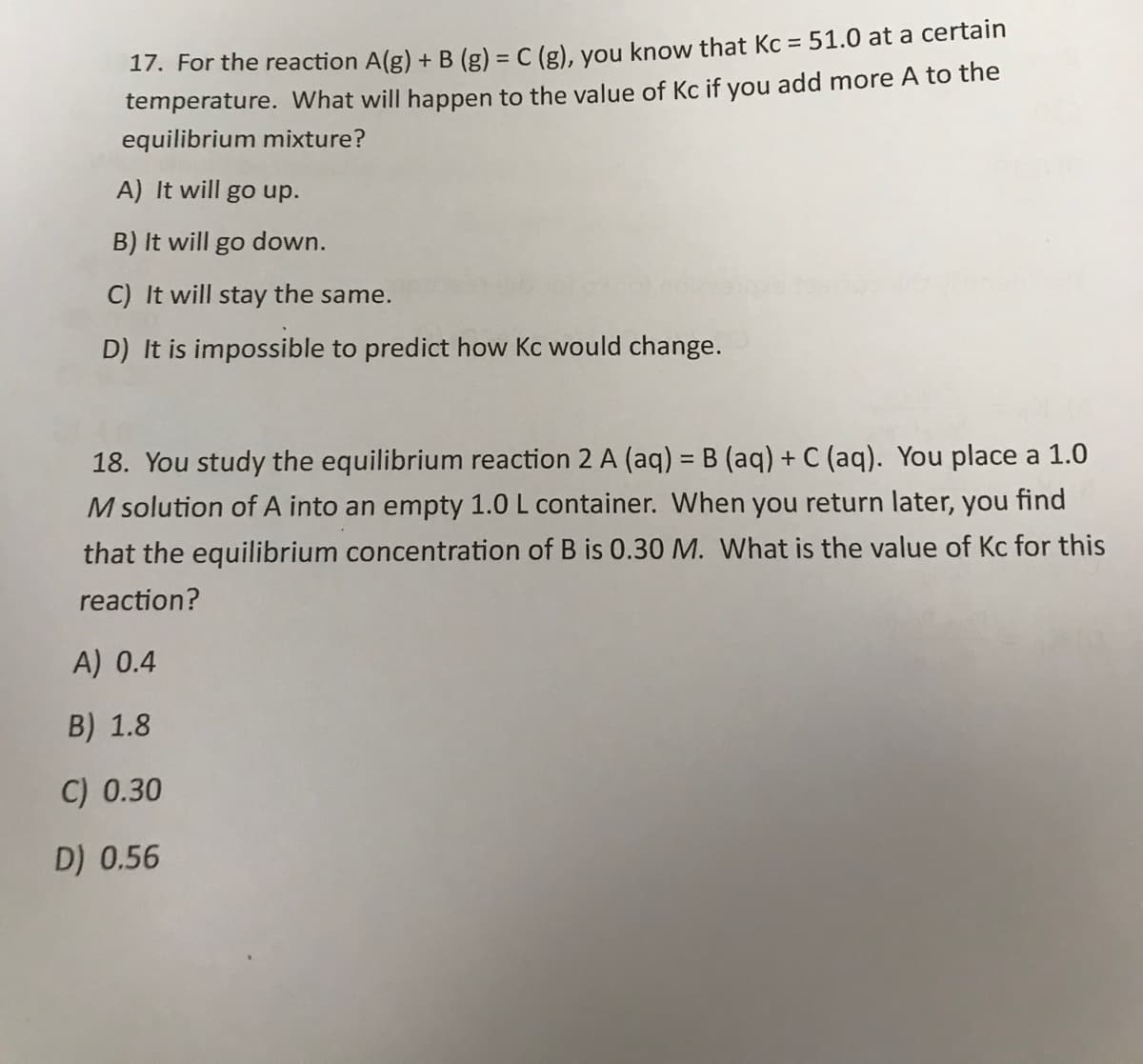17. For the reaction A(g) + B (g) = C (g), you know that Kc = 51.0 at a certain temperature. What will happen to the value of Kc if you add more A to the equilibrium mixture? A) It will go up. B) It will go down. C) It will stay the same. D) It is impossible to predict how Kc would change. 18. You study the equilibrium reaction 2 A (aq) = B (aq) + C (aq). You place a 1.0 M solution of A into an empty 1.0 L container. When you return later, you find that the equilibrium concentration of B is 0.30 M. What is the value of Kc for this reaction? A) 0.4 B) 1.8 C) 0.30 D) 0.56
17. For the reaction A(g) + B (g) = C (g), you know that Kc = 51.0 at a certain temperature. What will happen to the value of Kc if you add more A to the equilibrium mixture? A) It will go up. B) It will go down. C) It will stay the same. D) It is impossible to predict how Kc would change. 18. You study the equilibrium reaction 2 A (aq) = B (aq) + C (aq). You place a 1.0 M solution of A into an empty 1.0 L container. When you return later, you find that the equilibrium concentration of B is 0.30 M. What is the value of Kc for this reaction? A) 0.4 B) 1.8 C) 0.30 D) 0.56
Chemistry for Engineering Students
4th Edition
ISBN:9781337398909
Author:Lawrence S. Brown, Tom Holme
Publisher:Lawrence S. Brown, Tom Holme
Chapter12: Chemical Equilibrium
Section: Chapter Questions
Problem 12.98PAE
Related questions
Question

Transcribed Image Text:17. For the reaction A(g) +B (g) = C (g), you know that Kc = 51.0 at a certain
temperature. What will happen to the value of Kc if you add more A to the
equilibrium mixture?
A) It will go up.
B) It will go down.
C) It will stay the same.
D) It is impossible to predict how Kc would change.
18. You study the equilibrium reaction 2 A (aq) = B (aq) + C (aq). You place a 1.0
M solution of A into an empty 1.0 L container. When you return later, you find
that the equilibrium concentration of B is 0.30 M. What is the value of Kc for this
reaction?
A) 0.4
B) 1.8
C) 0.30
D) 0.56
Expert Solution
This question has been solved!
Explore an expertly crafted, step-by-step solution for a thorough understanding of key concepts.
Step by step
Solved in 3 steps with 3 images

Knowledge Booster
Learn more about
Need a deep-dive on the concept behind this application? Look no further. Learn more about this topic, chemistry and related others by exploring similar questions and additional content below.Recommended textbooks for you

Chemistry for Engineering Students
Chemistry
ISBN:
9781337398909
Author:
Lawrence S. Brown, Tom Holme
Publisher:
Cengage Learning

Chemistry: The Molecular Science
Chemistry
ISBN:
9781285199047
Author:
John W. Moore, Conrad L. Stanitski
Publisher:
Cengage Learning

Chemistry & Chemical Reactivity
Chemistry
ISBN:
9781133949640
Author:
John C. Kotz, Paul M. Treichel, John Townsend, David Treichel
Publisher:
Cengage Learning

Chemistry for Engineering Students
Chemistry
ISBN:
9781337398909
Author:
Lawrence S. Brown, Tom Holme
Publisher:
Cengage Learning

Chemistry: The Molecular Science
Chemistry
ISBN:
9781285199047
Author:
John W. Moore, Conrad L. Stanitski
Publisher:
Cengage Learning

Chemistry & Chemical Reactivity
Chemistry
ISBN:
9781133949640
Author:
John C. Kotz, Paul M. Treichel, John Townsend, David Treichel
Publisher:
Cengage Learning

Chemistry & Chemical Reactivity
Chemistry
ISBN:
9781337399074
Author:
John C. Kotz, Paul M. Treichel, John Townsend, David Treichel
Publisher:
Cengage Learning

Chemistry: An Atoms First Approach
Chemistry
ISBN:
9781305079243
Author:
Steven S. Zumdahl, Susan A. Zumdahl
Publisher:
Cengage Learning
